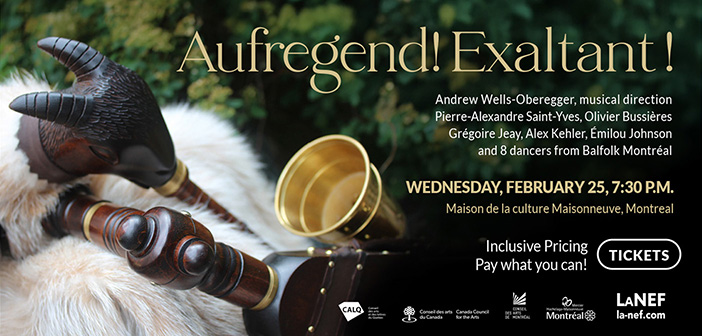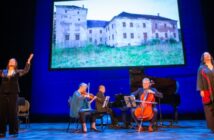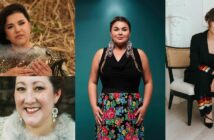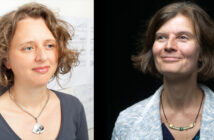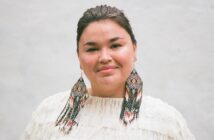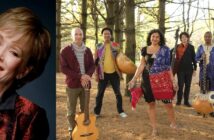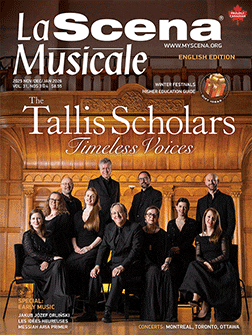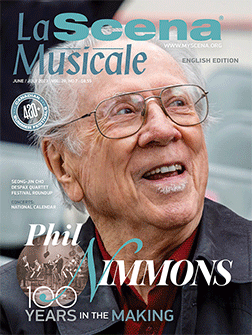
This page is also available in / Cette page est également disponible en:
Français (French)
International First Peoples’ Festival
Fans of the First Peoples’ Festival (IFPF) can rest assured that they will continue to experience this summer the same elements that have made the festival so popular: the large competitive video film section; concerts that will be creations and commissions—not just touring shows; the visual art section, to be held at La Guilde; and, last but not least, the activities on the Place des Festivals.
“Together with Daniel Áñez, who leads No Hay Banda, a group of musicians who also produce events, we have combined our efforts to bring the Chamber Ensemble of the Experimental Orchestra of Native Instruments (ECOEIN) from Bolivia,” begins artistic director André Dudemaine. The contemporary music orchestra uses traditional Quechua and Aymara instruments from Bolivia.
The native instruments are not tuned to European scales. “Composers who collaborate with the orchestra must have the melodic system of these instruments explained to them—a month-long artistic residency is a prerequisite for any collaboration,” explains Áñez. Some of the traditional square flutes, with holes, are called tarkas, and with them are obtained traditional chords that all have their own names. The sikus are small pipes of different sizes that are performed with someone, since one instrument does not have the whole key and another musician must fill in the missing notes of the melody.
The members of the ECOEIN will perform original works by Graciela Paraskevaídis, Cergio Prudencio, Tato Taborda and Canela Palacios, under the direction of Andrea Álvarez. The Andes ensemble is also currently working on transcribing recordings of forgotten melodies, with the idea of learning these pieces and transmitting them to the Aymara communities so they can reappropriate these long-neglected tunes.
Montrealers will discover these traditional tunes at the second, free, outdoor concert. “Members of the orchestra will also take part in the parade on the Place des Festivals—but, more important, they will offer a one-day sikus performance workshop.” Participants will be able to purchase a sikus specially imported from Bolivia for the occasion, which they will then be able to play with. Stay tuned for registration at www.nohaybanda.ca. La Sala Rossa, Aug. 15; Éthel parking lot, Aug. 18.
Posting rebellion
The patient resilience that has characterized IFPF for many years is now resolutely tinged with rebellion. On the event’s remarkable poster, commissioned from Mathieu Bergeron, a young musician, drum in hand, jumps on a skateboard above John Alexander MacDonald’s disemboweled head.
“We wanted to be caught in an act of dogged determination—to go back to our roots,” says André Dudemaine, who wanted to give a more accurate idea of the festival’s identity. Memories are short and, because of the reputation that the festival has acquired, some people forget that it was born in the aftermath of the Oka crisis. “There has been a very long road of resilience, but the Indigenous voice and its narrative, creative sovereignty have broken free.”
The poster is a reminder of the design of Place des Festivals the IFPF unveiled last year, with its skateboard ramp installed on the Promenade des Artistes. But a more painful subtext evokes the graves discovered near the residential schools. “The elders say the children are coming home and this once-stolen youth is returning to give a stronger voice to Indigenous rights,” says Dudemaine.
MacDonald was the architect of a system that relegated Aboriginal people to the ranks of those unable to care for themselves; he settled First Nations in preparation for the theft of their territories and helped develop residential schools. His statue loomed over Dominion Square, dressed as a knight of the Empire. Historians say that these actions must be considered through the eyes of the time. “But with whose eyes?” asks Dudemaine.
From North to South, statues have been taken down in the United States, Mexico, Colombia, Chile and Bolivia. The international affirmation of First Peoples feeds the festival, which in return feeds it. “It is important to capture the energy of this great decolonial current.” Aug. 8-17.
In June
As part of National Aboriginal History Month, IFPF presents Frétillant et agile, a work-in-progress of Jocelyn Sioui’s new show, which will be brought on stage next season. After the successful stage adaptation of his literary essay Mononk Jules, the accomplished storyteller and puppeteer turns his attention to a Wendat hero, the mysterious Auhaïtsic, who tries to save his nation from death. The whimsical work questions the overshadowed history. With the participation of composer and accordionist Luzio Altobelli and percussionist Bertil Shulrabe. Free, but inscription is required. June 20, Auditorium de la Grande Bibliothèque.
Finally, with the support of the Old Port Corp., IFPF invites Montrealers to the Quai de l’Horloge for a ritual and civic celebration of the Solstice, with a tobacco ceremony, evocations of the Mohawk Elders of Kahnawake, ignition of the day’s fire corresponding to the solar zenith, and traditional drumming. The talented Shauit will perform excerpts from Natukun, his brand-new Innu folk album—a record of genuine friendship and reconciliation. June 21, Quai de l’Horloge. www.presenceautochtone.ca
Kahnawake Powwow
Powwow is a word of Algonquin origin which means a gathering of people from different nations. The First Nations have always met to exchange and celebrate, but powwows were forbidden by the Canadian government until 1951 in an attempt to eradicate Indigenous culture. In a perspective of reconciliation, visitors are now invited to powwows organized each summer throughout the country.
These get-togethers feature traditional dancing, drumming, singing and food. Near Montreal, dancers from all nations converge at Echoes of a Proud Nation, the Kahnawake Powwow. Dressed in regalia, the traditional dress made for this unique event, dancers compete in various categories to win the prizes at stake—a total of about $40,000. The powwow experience is a highly colourful, friendly and unforgettable one. July 8-9. www.kahnawakepowwow.com
Festival Innu Nikamu
Why not venture to the North Shore of Quebec and discover the Festival Innu Nikamu? Near Sept-Îles, the Maliotenam area is a longtime focal point for the Innu people of the region. And the community took off artistically after its residential school closed in the 1970s.
Festival Innu Nikamu (literally “he sings in Innu”) is, therefore, supported by a close-knit community that expresses its identity through its creativity and its music. During four days, this great family alcohol- and drug-free celebration brings together several native nations. The event takes place on the site of the former Notre-Dame de Maliotenam residential school, turning the place with its dark past into a celebration of Innu culture.
With 33 years of experience, Festival Innu Nikamu is now one of the most important Aboriginal music and art festivals in North America. Its program features musicians, artists and performers from the First Nations of Quebec and Canada as well as international guests. Quebec artists share the stage as special guests. The local residents and neighbouring towns participate in the festivities, creating a real link between the various communities of the North Shore.
This year, the festival will welcome one of its founding members and ardent supporter Florent Vollant, plus fellow musicians with Quebec roots Richard Seguin, Beatrice Deer, Natasha Kanapé Fontaine, Claude McKenzie, rappers Loud and Souldia, as well as the internationally known Gipsy Kings, founded in France but with roots in Spanish culture. So come to the festival in Maliotenam and experience the great buffet of traditional food (salmon, caribou, beaver, bustard), the music and the encounters. Aug. 1-6. www.innunikamu.ca
Playlist
https://www.youtube.com/watch?v=AQKrXhC_Aw8
https://www.youtube.com/watch?v=29ECKTELi5M
https://www.youtube.com/watch?v=ykjBAn3vELY
https://www.youtube.com/watch?v=OxqYdDgfvBA&t=35s
https://www.youtube.com/watch?v=81hmuIjKrYk
https://www.youtube.com/watch?v=OMKuLfhtBAU
https://www.youtube.com/watch?v=66irifR7AHE
https://www.youtube.com/watch?v=hPJmIbghwBM
https://www.youtube.com/watch?v=Gy9gJ3jj3lE
This page is also available in / Cette page est également disponible en:
Français (French)


